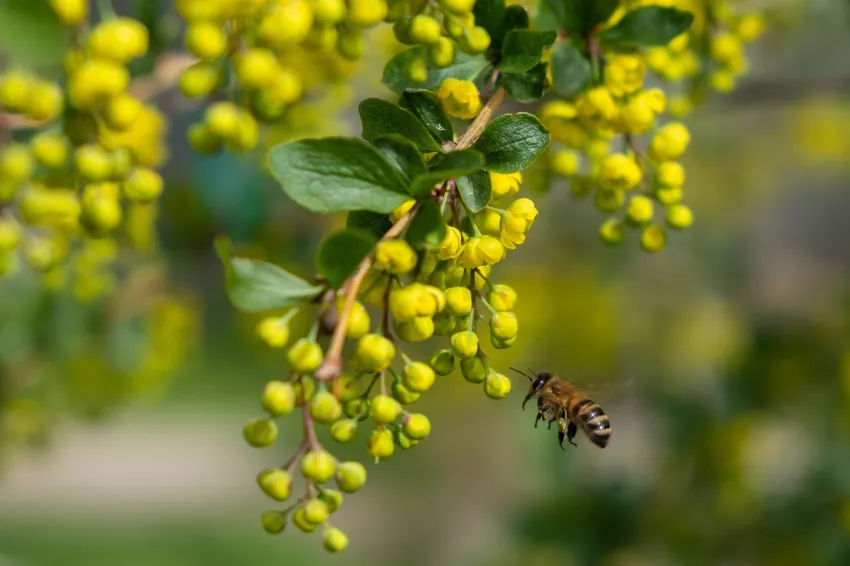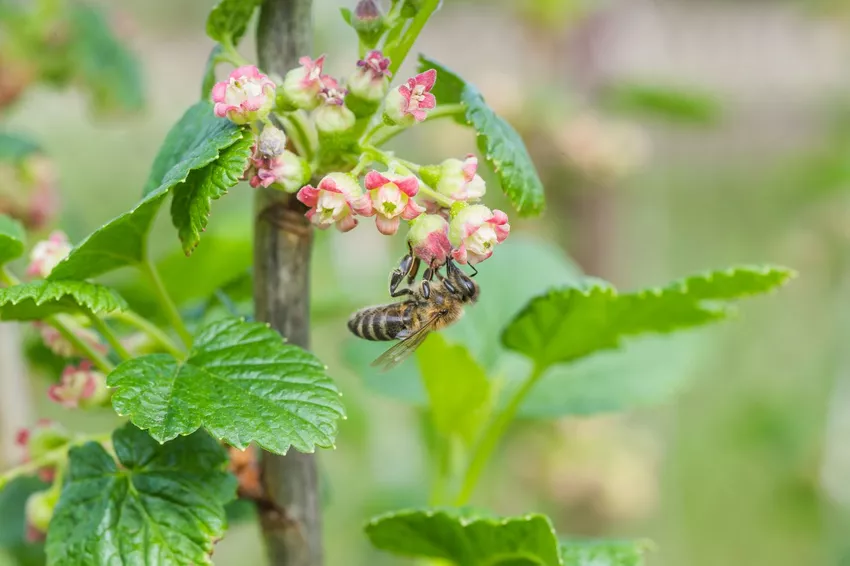Choosing the right plants for a bee-friendly garden is not always easy. Here you will find 15 great bee bushes for the garden.

When people think of bee-friendly plants, colorful blooming flowers spring to mind. However, not only bee-friendly flowers attract the little buzzers into the garden - numerous shrubs and woody plants also often offer the animals a lucrative source of food, even if it may not seem so at first glance. The most inconspicuous flowers, which are hardly appreciated in our garden, are often particularly important for the bees. Here you can find out which shrubs are ideal for bee pasture and which do not help the small animals.
Shrubs are an absolute must in garden design, because they bring height and structure to the bed. If you are careful when choosing the right trees, you can also help the bees at the same time. But not all shrubs are suitable for bees: conifers, for example, offer wild bees no food at all. Exotic plants, such as forsythia (Forsythia), are also useless for beneficial insects because their flowers produce neither pollen nor nectar. You can find out which plants are better for designing a bee-friendly garden in our top 15.
1. Hibiscus
The exotic hibiscus (Hibiscus), also known as the rose mallow, is extremely popular for its large, colorful flowers. In the past, the mallow plant (Malvaceae) was particularly popular as a houseplant, but the hibiscus is becoming more and more common as a garden plant. Here the plant with the spectacular flowers is also popular with bees. In fact, it only offers the small insects little nectar, but hibiscus is considered a good source of pollen. Its flowering period from July to September is also particularly advantageous for the bees, as many other perennials have already faded by this time and the food supply is slowly becoming scarce.

Anyone lookingIf.webp you are looking for a hard-wearing and at the same time easy-care hedge, you will quickly find what you are looking for in the privet (Ligustrum vulgare): It impresses with its densely branched growth, rapid growth and its evergreen foliage. But not only people benefit from the robust bee bush - in fact, the privet is one of the few bee-friendly hedge plants. From June onwards, the plant adorns itself with dainty, delicate white panicles of flowers that exude a wonderful scent and attract numerous beneficial insects.

3. Copper Rock Pear
The copper pear (Amelanchier lamarckii) was one of the rather unknown fruit varieties for a long time, but has recently gained in popularity. No wonder, after all, the plant can have some advantages. The copper rock pear impresses visually with its impressive play of colors: the leaves are copper-colored when they sprout, turn green in summer and finally take on an intense autumn color. But their tasty fruits and their easy-care nature also make the pear very popular. In April it forms numerous star-shaped flowers, which prove to be a real bee magnet and attract dozens of beneficial insects.

The hawthorn (Crataegus) is a popular shrub in garden design because it is considered particularly undemanding and easy to care for. Particularly difficult soil conditions as well as drought and heat hardly affect the plant. With its densely branched branches and the often sprawling crowns, it is not to be sneezed at either visually - some hawthorn species even develop an extraordinarily beautiful autumn color. In May and June, the plant shows an almost endless number of small white or pink flowers and is therefore also very popular with bees.

5. Snowberry
With its long arching branches, the snowberry (Symphoricarpos albus var. laevigatus ) a particularly elegant shrub plant in summer. From June it shows its numerous white berries, which remain on the plant all winter, but it becomes a real eye-catcher. Bees also like the modern-looking shrub: the small bell-shaped flowers, which the plant develops between June and September, look very attractive at first glanceinconspicuous, but form a particularly rich source of nectar for bees and bumblebees.

With the barberry (Berberis) perfect hedges can be created that not only reliably keep prying eyes and unwanted intruders away, but are also particularly easy to care for. The evergreen shrubs impress with their elongated leaves, which often show great autumn colors, and their small fruits, which are popular with humans and animals as a snack. But while the dense foliage and sharp thorns of the barberry ensure that unwanted guests stay outside, the small yellow flowers attract countless insects. Sand bees in particular, but also bumblebees and other beneficial insects, find a valuable source of food in the barberry.

7. Fingerbush
Whether one should still speak of a shrub or rather of a ground cover with a size of only 15 centimeters is probably up to everyone. However, the cinquefoil (Potentilla tridentata) shows impressively that size is not the only thing that matters: the plant is hardy, robust and easy to care for, feeling at home almost anywhere. The cinquefoil is particularly beautiful in May, when the dark green leaves contrast with the white starry flowers. These often bloom into August and thus provide bees with a reliable supply of food for a long time.

8. willow
The willow (Salix) is probably one of the best-known trees and shrubs in our region. In addition to the shrubs that are often encountered, there are also creeping species and large trees. Their dioeciousness makes the willow something special - there are both purely male and female willows. While the male plants form particularly eye-catching flowers, which mainly contain pollen, female flowers provide bees with the coveted nectar. In fact, some sand bee species have even specialized in pastures, as these are a particularly good source of food. Above all, the Sal willow (Salix caprea) is very popular with striped beneficial insects - due to its early flowering and its high pollen and nectar content, it is an important food source for wild bees.

9. Fake Jasmine
The false jasmine(Philadelphus coronarius), also known as scented or farmer's jasmine or mock orange, is probably one of the most popular scented plants and can therefore be found in many gardens. With its elegant, overhanging growth and matt green leaves, the bee-friendly shrub is a modern eye-catcher in the garden. However, it only looks particularly beautiful at the end of May - then the plant transforms into a sea of seductive flowers that bathe the garden in brilliant white and exude an intense smell. But not only people love the false jasmine, bees are also real lovers of the plant, which offers them plenty of food.

10. Cornus
Even if the cornelian cherry (Cornus mas) has a similar name to our cherry tree (Prunus avium), the two trees are still not related to each other. Instead, the cornel belongs to the dogwood family. The only thing they have in common: the cornelian cherry also bears shiny red fruits in summer, which are very similar to cherries. However, their fruits are significantly tart and sour in taste. Bees particularly like the cornel because of its lemon-yellow umbels of flowers, which the plant shows as early as February. This means that the cornelian cherry is one of the first to bloom in spring and offers the bees a particularly good opportunity to fill up their reserves after the long winter.

11. Wild Roses
Roses (Rosa) are rather unusual in connection with bee-friendly plants: The plants are often criticized because their very double flowers prevent insects from finding nectar and pollen and thereby blocking them from their food source. However, this only applies to modern cultivated roses - wild roses such as the vinegar rose (Rosa gallica) or the potato rose (Rosa rugosa) form a strong contrast and are almost besieged by bees and bumblebees, as they offer a plentiful supply of food. But other animal species also benefit from wild roses: Birds like to use the rose hips as food, and the dense shrubs also offer many native animal species such as hedgehogs protection and cover. On the other hand, wild roses are popular with gardeners because of their easy-care nature and their natural charm, which does not require double flowers.

12.Mustache
With its impressive blue inflorescences, the bearded beard (Caryopteris clandonensis) draws envious glances: from July, the plant turns into a veritable sea of blossoms, which cover the plant until the first Give frost a unique look. But their aromatic scent and their elongated green-grey leaves also make the plants a real asset to the garden. Even bees love the easy-care subshrub. So the whisker not only offers you an almost endless selection of flowers over a very long period of time, but also produces a lot of nectar and pollen during this time.

13. Sloe
In April and May, the sloe (Prunus spinosa) bears countless small, white flowers that envelop the bee bush like a cloud. A paradise for the small striped beneficial insects, which go in search of food again for the first time at this time of year. Luckily, the flowers of the sloe not only look good and smell wonderful, they also provide hungry beneficial insects with enough nectar and pollen to replenish their supplies. But even after flowering, the sloe is not to be despised visually: the thorny, black shoots, which have also given the plant its name blackthorn, ensure an attractive appearance in combination with the dark, matt green leaves. In autumn, the sloe also produces tart, aromatic fruits that are not only tasty for birds, but also for humans.

14. Ivy
Ivy (Hedera helix) as bee pasture? Although the umbels of the ivy are so inconspicuous that they are often not even noticed, the climbing plant is one of the most important food sources for beneficial insects such as bees and native butterflies. In fact, the plant is one of the few real autumn flowers: from September to October, ivy offers pollen and nectar that are easily accessible to insects, which means that it can extend the animals' feeding period even further. But the plant is also a real enrichment for people: easy to care for and robust, it is not only ideal as a privacy screen or green wall, but is also one of the air-purifying plants.

15. Berry bushes
currants (Ribes), raspberries (Rubus idaeus) or gooseberries (Ribes uva-crispa) - for many gardeners, berry bushes with their sweet fruits are the best part of the summer. But not only people enjoy the delicious delicacies, bees can't get enough of them either. In fact, almost all berry bushes have a very good nectar and pollen production, which makes them an important source of food for the small insects. The raspberry in particular is considered to be extremely bee-friendly: not only does it have the highest pollen and nectar value of all berry bushes, its long flowering period, which can last from May to August, also makes it a reliable source of food.

Tip: Plantura insect seeds optimally provide the beneficial insects in your garden with food for many months. The Plantura bee pasture, for example, contains over 20 different types of flowers and herbs. In this way, you can soon transform your garden into a real paradise for bees.
You haven't found the right plant for your bee garden yet? Check out our article on bee-friendly perennials.